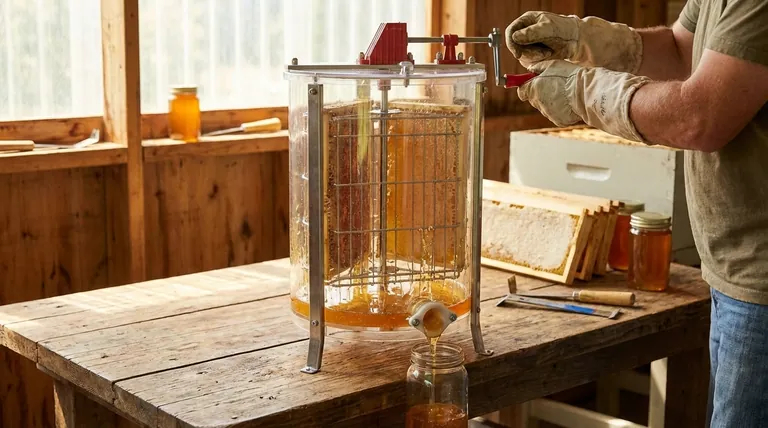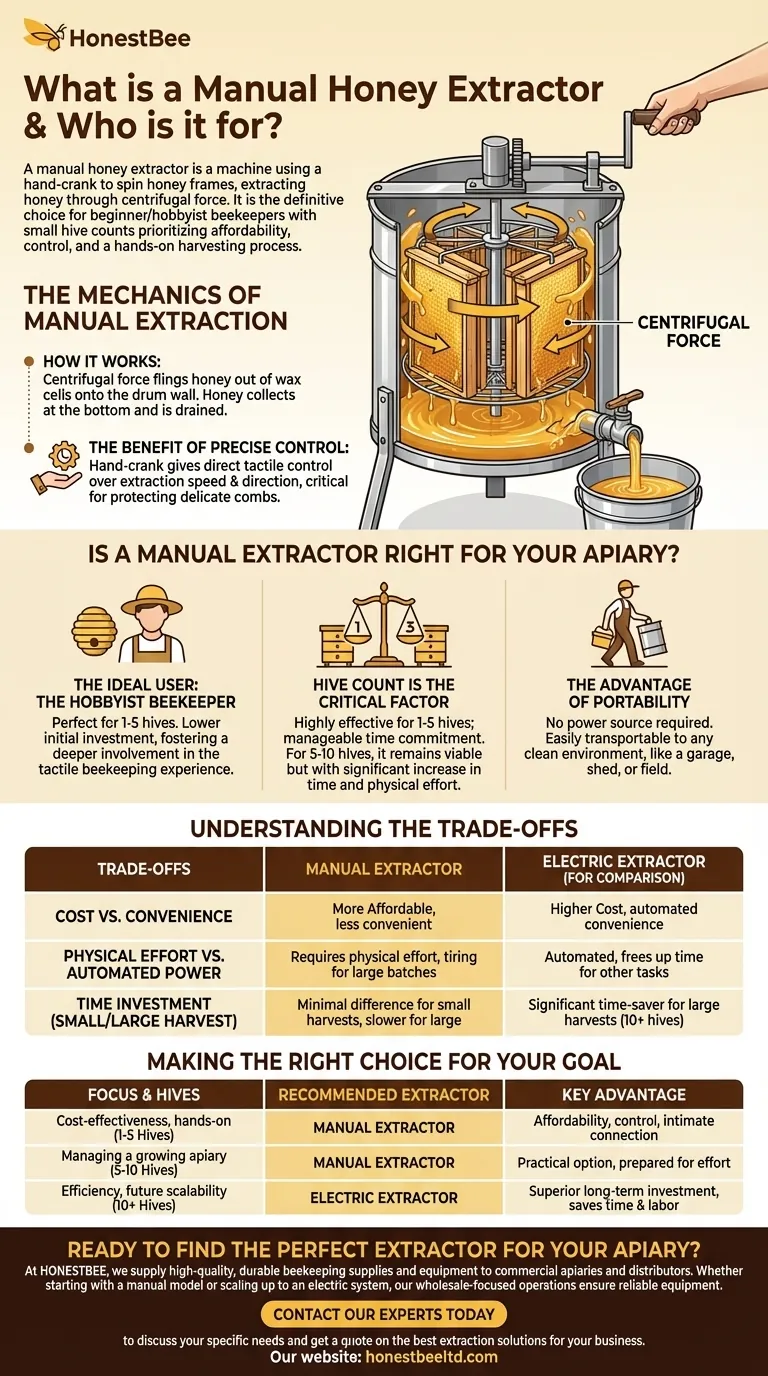In short, a manual honey extractor is a machine that uses a hand-crank to spin honey frames, extracting the honey through centrifugal force. It is the definitive choice for beginner or hobbyist beekeepers with a small number of hives who prioritize affordability, control, and a hands-on connection to the harvesting process.
The decision between a manual and an electric extractor is not about which is "better," but about aligning the tool with your scale and philosophy. A manual extractor trades the efficiency of automation for greater control, lower cost, and operational simplicity, making it the perfect starting point for most small-scale beekeepers.

The Mechanics of Manual Extraction
A manual extractor is a simple yet effective piece of equipment. Its design is centered on one core principle: using force to separate honey from the wax comb without destroying the comb itself.
How It Works: Centrifugal Force
The extractor works much like a salad spinner. As you turn the hand-crank, a geared mechanism spins a basket holding the honey frames. This rotation generates centrifugal force, which flings the liquid honey out of the wax cells and onto the inner wall of the extractor drum.
The honey then drips down the wall and collects at the bottom, where it can be drained through a gate or valve.
The Benefit of Precise Control
The hand-crank gives you direct, tactile control over the extraction speed and direction. This is critical for protecting your combs.
Starting slowly allows you to extract honey from one side of the frame without the weight of the honey on the other side causing the delicate wax foundation to blow out. You can then flip the frames and repeat the process, gradually increasing speed.
Is a Manual Extractor Right for Your Apiary?
The primary factors influencing this decision are your hive count, budget, and personal beekeeping goals. For many, a manual model is the most logical and practical choice.
The Ideal User: The Hobbyist Beekeeper
Manual extractors are perfectly suited for beekeepers who manage a few hives. Their lower cost makes the initial investment in honey harvesting equipment far more accessible.
They also appeal to those who enjoy the tactile experience of beekeeping. Manually cranking the frames fosters a deeper involvement in the process, turning a chore into a rewarding activity.
Hive Count is the Critical Factor
The most significant consideration is scale. A manual extractor is highly effective for someone managing 1 to 5 hives. Processing the honey from this number of colonies is manageable and does not represent an overwhelming time commitment.
As you approach 5 to 10 hives, a manual extractor is still viable, but the time and physical effort required will increase significantly.
The Advantage of Portability
Because they do not require an external power source, manual extractors are exceptionally portable. You can set up your extraction station in a garage, a shed, or even in the field, as long as you can maintain a clean, bee-free environment.
Understanding the Trade-offs
Choosing a manual extractor involves a clear set of compromises. Being aware of them ensures you are making an informed decision that you will not regret as your apiary grows.
Cost vs. Convenience
The most obvious trade-off is cost. Manual extractors are significantly more affordable than their electric counterparts, making them the default choice for beginners on a budget.
This lower cost comes at the expense of convenience. An electric model automates the spinning process, freeing you up to perform other tasks like uncapping the next batch of frames.
Physical Effort vs. Automated Power
A manual extractor requires physical effort. While the work is not overly strenuous for a small batch, harvesting honey from multiple hives can become a tiring, repetitive task.
Beekeepers with physical limitations or those who simply wish to minimize labor should strongly consider the long-term benefits of an electric model, even if the initial cost is higher.
Time Investment for Small vs. Large Harvests
For a small harvest, the time difference between a manual and electric extractor is minimal. However, for harvests exceeding ten hives, the efficiency of an electric model becomes undeniable. It can reduce extraction time by hours, making it a near necessity for any medium to large-scale operation.
Making the Right Choice for Your Goal
Select your equipment based on a realistic assessment of your current needs and future ambitions.
- If your primary focus is cost-effectiveness and hands-on learning (1-5 hives): A manual extractor is the ideal tool, offering affordability and an intimate connection to the harvest.
- If your primary focus is managing a growing apiary (5-10 hives): A manual extractor remains a practical option, but be prepared for the significant time and labor commitment during harvest.
- If your primary focus is efficiency and future scalability (10+ hives): An electric extractor is the superior long-term investment that will save you invaluable time and labor.
Ultimately, choosing the right extractor empowers you to enjoy the rewards of your hard work efficiently and effectively.
Summary Table:
| Feature | Best For | Hive Count | Key Advantage |
|---|---|---|---|
| Manual Extractor | Hobbyists & Beginners | 1 - 5 hives | Affordability, hands-on control, portability |
| Electric Extractor | Medium/Large-scale Operations | 5+ hives | Efficiency, time-saving, reduced physical effort |
Ready to find the perfect extractor for your apiary?
At HONESTBEE, we supply high-quality, durable beekeeping supplies and equipment to commercial apiaries and distributors. Whether you're starting with a manual model or scaling up to an electric system, our wholesale-focused operations ensure you get the reliable equipment you need.
Contact our experts today to discuss your specific needs and get a quote on the best extraction solutions for your business.
Visual Guide

Related Products
- HONESTBEE 3-Frame Manual Acrylic Honey Extractor
- Plastic Hand Crank 2 Frame Honey Extractor Low Price
- 6 Frame Manual Stainless Steel Honey Extractor Beekeeping Equipment
- 2 Frame Stainless Steel Manual Honey Spinner Extractor for Beekeeping
- Stainless Steel 3 Frame Manual Honey Extractor Spinner for Bee Honey Extraction
People Also Ask
- Which type of honey extractor is generally more durable? Focus on Material & Build Quality for Longevity
- How do you collect honey at home? A Beginner's Guide to Harvesting from Your Hive
- What machines are needed in beekeeping besides basic tools? Scale Your Honey Harvest Efficiently
- What is the most common method for cleaning a honey extractor? Protect Your Honey & Equipment
- What size honey extractor do I need? Match Frame Capacity to Your Hives for Maximum Efficiency



















